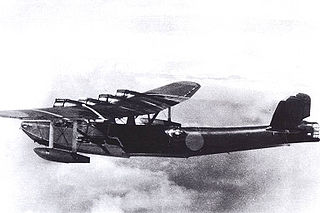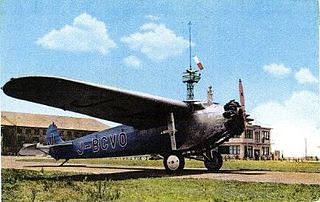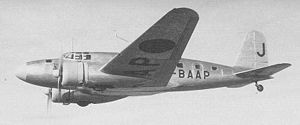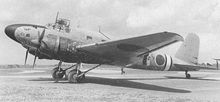
The Kawanishi H6K was an Imperial Japanese Navy flying boat produced by the Kawanishi Aircraft Company and used during World War II for maritime patrol duties. The Allied reporting name for the type was Mavis; the Navy designation was "Type 97 Large Flying Boat" (九七式大型飛行艇). Developed in the 1930s, it was used for reconnaissance, transport, bombing, naval warfare, and executive transport by the Imperial Japanese Navy. The national airline also used it as commercial airliner. The British mistakenly identified this aircraft as the Kawanishi Navy 97 Mavis.

The Mitsubishi Ki-46 was a twin-engine reconnaissance aircraft that was used by the Imperial Japanese Army in World War II. Its Army Shiki designation was Type 100 Command Reconnaissance Aircraft (一〇〇式司令部偵察機); the Allied brevity code name was "Dinah".

The Mitsubishi Ki-67Hiryū was a twin-engine bomber produced by Mitsubishi Aircraft Company and used by the Imperial Japanese Army Air Service and Imperial Japanese Navy Air Service in World War II. While its original official designation was "Army Type 4 Heavy Bomber", in all of its key parameters, the Ki-67 was similar to the contemporaneous medium bombers of other countries. Japanese Navy variants included the P2M and Q2M.

The Kawasaki Ki-45 Toryu was a two-seat, twin-engine heavy fighter used by the Imperial Japanese Army in World War II. The army gave it the designation "Type 2 Two-Seat Fighter"; the Allied reporting name was "Nick". Originally serving as a long-range escort-fighter, the design — as with most heavy fighters of the period — fell prey to smaller, lighter, more agile single-engine fighters. As such, the Ki-45 instead served as a day and nighttime interceptor and strike fighter.

The Lockheed Model 14 Super Electra was an American civil passenger and cargo aircraft built by the Lockheed Aircraft Corporation during the late 1930s. An outgrowth of the earlier Model 10 Electra, the Model 14 was also developed into larger, more capable civil and military versions.

The Kawasaki Ki-32 was a Japanese light bomber aircraft of World War II. It was a single-engine, two-seat, mid-wing, cantilever monoplane with a fixed tailwheel undercarriage. An internal bomb bay accommodated a 300 kg (660 lb) offensive load, supplemented by 150 kg (330 lb) of bombs on external racks. During the war, it was known by the Allies by the name Mary. It was, however, mistakenly identified by the British as the Kawasaki Army KB-97 Mary.

The Mitsubishi Ki-21, formal designation "Type 97 Heavy Bomber" was a Japanese heavy bomber during World War II. It began operations during the Second Sino-Japanese War participating in the Nomonhan Incident, and in the first stages of the Pacific War, including the Malayan, Burmese, Dutch East Indies and New Guinea Campaigns. It was also used to attack targets as far-flung as western China, India and northern Australia. The Allies designated it under the reporting names "Sally" /"Gwen".

The Nakajima G5N Shinzan was a four-engined long-range heavy bomber designed and built for the Imperial Japanese Navy prior to World War II. The Navy designation was "Experimental 13-Shi Attack Bomber"; the Allied code name was "Liz".

The Tachikawa Ki-74 was a Japanese experimental long-range reconnaissance bomber of World War II. A twin-engine, mid-wing monoplane, it was developed for the Imperial Japanese Army Air Service but never deployed in combat. The Ki-74 was designed for high altitude operation with a pressurized cabin for its crew.

The Nakajima Ki-49Donryu was a twin-engine Japanese World War II heavy bomber. It was designed to carry out daylight bombing missions, without the protection of escort fighters. Consequently, while its official designation, Army Type 100 Heavy Bomber, was accurate in regard to its formidable defensive armament and armor, these features restricted the Ki-49 to payloads comparable to those of lighter medium bombers – the initial production variant could carry only 1,000 kg (2,200 lb) of bombs.

The Nakajima Ki-34 was a Japanese light transport of World War II. It was a twin-engine, low-wing monoplane; the undercarriage was of tailwheel type with retractable main units. During the Pacific War, the Allies assigned the type the reporting name Thora.

The Mitsubishi Ki-15Army Type 97 Command Reconnaissance aircraft was a Japanese reconnaissance aircraft and a light attack bomber of the Second Sino-Japanese War and Pacific War. It began as a fast civilian mail-plane. It was a single-engine, low-wing, cantilever monoplane with a fixed tailwheel undercarriage; it carried a crew of two. It served with both the Imperial Japanese Army and Navy. During World War II it was code-named "Babs" by the Allies.

The Kawanishi E7K was a Japanese three-seat reconnaissance seaplane mainly in use during the 1930s. It was allocated the reporting name Alf by the Allies of World War II.

The Kokusai Ki-59 was an early 1940s light transport monoplane built by Nippon Kokusai Koku Kogyo K.K for the Imperial Japanese Army as a development of the Teradako-ken TK-3 which had first flown in 1938.

The Mitsubishi Ki-2 was a light bomber built by Mitsubishi for the Imperial Japanese Army Air Service (IJAAS) in the 1930s. Its Allied nickname was "Louise". Despite its antiquated appearance, the Ki-2 was successfully used in Manchukuo and in North China during the early stages of the Second Sino-Japanese War, in areas where danger from enemy fighter aircraft was minimal. It was later used in a training role.

The Nakajima Ki-6 was a licensed-produced version of the Fokker Super Universal transport built by Nakajima Aircraft Company in the 1930s. Initially used as an airliner, the militarized version was used by the Imperial Japanese Army in a variety of roles, ranging from medical evacuation to transport and training aircraft. It was used extensively in combat zones in Manchukuo and in China during the Second Sino-Japanese War.

The Mitsubishi K3M was a trainer built by Mitsubishi which was used by the Imperial Japanese Navy in an extremely wide variety of roles, including light transport, liaison aircraft, utility aircraft and occasionally light bomber. Its Allied reporting name was Pine.
The Nakajima Ha5 is a twin row, 14 cylinder air-cooled radial aircraft engine built by the Japanese Nakajima Aircraft Company. The engine was a development of earlier single-row Japanese engines, the Kotobuki and Hikari, which had combined features of the Bristol Jupiter and Pratt & Whitney R-1340 Wasp designs.
The Mitsubishi Zuisei was a 14-cylinder, supercharged, air-cooled, two-row radial engine used in a variety of early World War II Japanese aircraft. It was one of the smallest 14-cyl. engines in the world and the smallest diameter Japanese engine. The Mitsubishi model designation for this engine was A14 while it was an experimental project, in service it was known as the MK2, followed by the revision code letter, and known as the Ha-26 and Ha-102 by the Army and "Zuisei" by the Navy. Unified designation code was Ha-31.

The Shōwa L2D and Nakajima L2D, given the designations Shōwa Navy Type 0 Transport and Nakajima Navy Type 0 Transport(零式輸送機), were license-built versions of the Douglas DC-3. The L2D series, numerically, was the most important Japanese transport in World War II. The L2D was given the Allied code name Tabby.





















